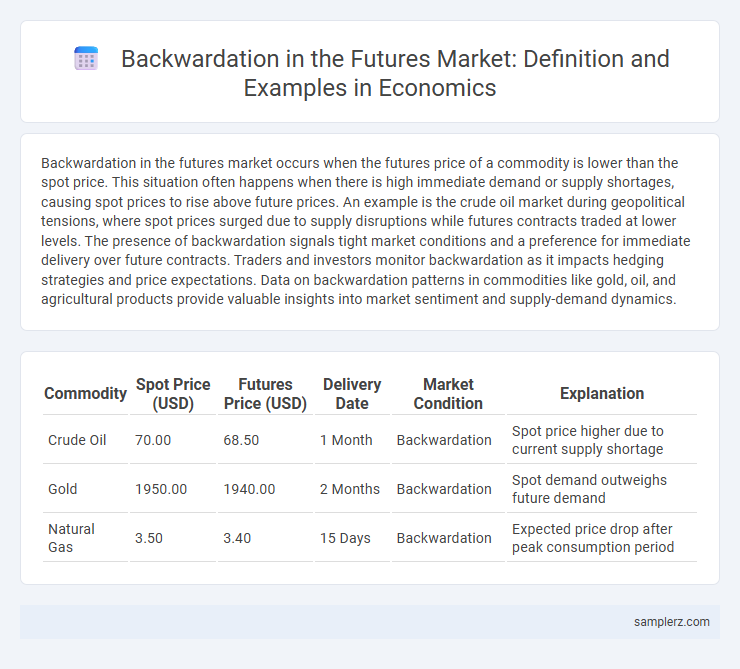Backwardation in the futures market occurs when the futures price of a commodity is lower than the spot price. This situation often happens when there is high immediate demand or supply shortages, causing spot prices to rise above future prices. An example is the crude oil market during geopolitical tensions, where spot prices surged due to supply disruptions while futures contracts traded at lower levels. The presence of backwardation signals tight market conditions and a preference for immediate delivery over future contracts. Traders and investors monitor backwardation as it impacts hedging strategies and price expectations. Data on backwardation patterns in commodities like gold, oil, and agricultural products provide valuable insights into market sentiment and supply-demand dynamics.
Table of Comparison
| Commodity | Spot Price (USD) | Futures Price (USD) | Delivery Date | Market Condition | Explanation |
|---|---|---|---|---|---|
| Crude Oil | 70.00 | 68.50 | 1 Month | Backwardation | Spot price higher due to current supply shortage |
| Gold | 1950.00 | 1940.00 | 2 Months | Backwardation | Spot demand outweighs future demand |
| Natural Gas | 3.50 | 3.40 | 15 Days | Backwardation | Expected price drop after peak consumption period |
Understanding Backwardation in the Futures Market
Backwardation occurs in the futures market when the futures price of a commodity is lower than its current spot price, often due to immediate demand exceeding supply. This phenomenon commonly appears in markets for perishable goods like crude oil or agricultural products, where storage costs and the urgency to sell influence pricing. Traders interpret backwardation as a signal of short-term scarcity or strong present demand relative to future supply expectations.
Key Characteristics of Backwardation
Backwardation in the futures market occurs when the futures price of a commodity is lower than the expected spot price at contract maturity, indicating strong current demand or supply constraints. Key characteristics include a downward-sloping futures curve, positive convenience yield for holders of the physical commodity, and market expectations of rising future prices. This situation often signals short-term scarcity and incentivizes immediate selling over storage.
Real-World Examples of Backwardation
Oil futures markets frequently exhibit backwardation during supply constraints when near-term contracts command higher prices than longer-term ones due to immediate demand pressures. The gold market has also experienced backwardation during times of significant geopolitical uncertainty, reflecting a premium on immediate delivery over future contracts. Agricultural commodities like wheat occasionally show backwardation during harvest season disruptions, signaling tight spot supply relative to futures prices.
Backwardation in Commodity Markets: Case Studies
In commodity markets, backwardation occurs when futures prices are lower than the spot price, often due to supply shortages or high demand for immediate delivery. A notable example is crude oil in 2020, where geopolitical tensions and supply disruptions caused futures contracts to trade below spot prices. This backwardation indicated tight supply conditions and incentivized market participants to hold physical inventory rather than futures contracts.
Oil Futures: A Historical Example of Backwardation
Oil futures markets have historically experienced backwardation, a condition where the spot price exceeds future contract prices, often during supply shortages or geopolitical tensions. A notable example occurred during the 2008 oil crisis, when tight supply and high immediate demand pushed spot prices above futures prices. This backwardation signaled market expectations of easing supply constraints and falling prices in the future.
Agricultural Products and Periods of Backwardation
Backwardation in agricultural futures markets often occurs during harvest seasons when immediate supply exceeds future demand, causing spot prices to be higher than futures prices. For example, wheat and corn contracts frequently exhibit backwardation in late summer and early fall, reflecting abundant harvest output and storage costs. This price pattern incentivizes immediate sale over storage, influencing farmers' and traders' short-term strategies.
Impact of Supply Shocks on Futures Backwardation
Supply shocks, such as sudden disruptions in oil production due to geopolitical tensions, often trigger futures market backwardation by causing immediate spot prices to spike above future contract prices. This pricing anomaly reflects market expectations that supply constraints will ease over time, leading to lower prices in the futures months. Backwardation incentivizes holders to release physical commodities promptly, stabilizing the market while signaling tight current supply conditions.
The Role of Seasonal Demand in Creating Backwardation
Seasonal demand significantly impacts backwardation in futures markets, particularly in commodities like natural gas and agricultural products where supply tightens during peak consumption periods. When expected spot prices rise above futures prices due to anticipated seasonal shortages, traders bid up current contracts to secure immediate delivery, generating backwardation. This pricing pattern reflects market expectations of higher spot prices driven by cyclical demand shifts, influencing hedging and speculation strategies.
How Backwardation Affects Investors and Traders
Backwardation in the futures market signals that spot prices exceed futures prices, prompting investors to prioritize immediate delivery over future contracts. Traders often capitalize on backwardation by executing short-term trades to profit from price convergence as futures prices rise toward spot levels. This market condition can reduce holding costs and encourage increased liquidity, benefiting investors who strategically time their entries and exits.
Comparing Backwardation Versus Contango in Economic Context
Backwardation in futures markets occurs when the futures price of a commodity is lower than the spot price, often signaling supply shortages or high demand, exemplified by oil futures during geopolitical tensions. Contango, in contrast, reflects a situation where futures prices exceed spot prices, suggesting storage costs or expectations of future price increases, commonly observed in stable, well-supplied markets like natural gas. Understanding the divergence between backwardation and contango aids economists in interpreting market sentiment, inventory levels, and potential price movements within commodity trading.

example of backwardation in futures market Infographic
 samplerz.com
samplerz.com